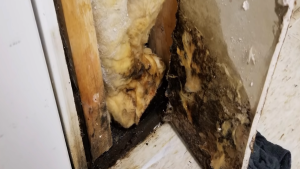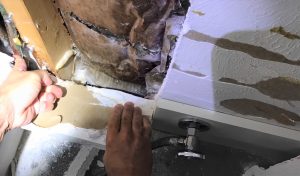Unveiling the Hidden: How to Detect Mold Behind Drywall
Mold is a common yet silent intruder that can cause health issues and damage the structure of your home. Identifying and addressing mold growth behind drywall can be a challenge, but timely intervention is essential to safeguard your living environment. In this article, we will discuss how to determine if mold is lurking behind your drywall and what steps you can take to combat the problem.

Signs of Mold Behind Drywall
- Musty Odor: A persistent, musty smell is often the first indication of mold growth in your home. Mold produces volatile organic compounds (VOCs) that create a distinctive odor. If you notice an unusual, unpleasant smell that does not dissipate even after cleaning and airing out the area, mold may be hiding behind your drywall.
- Discoloration or Stains: Visible signs of water damage, such as discoloration, staining, or peeling paint, can suggest potential mold growth behind the drywall. These signs often appear in the form of brown or yellow spots or streaks.
- Warped or Bubbling Drywall: Moisture can cause drywall to warp or bubble. If you observe these symptoms, it is possible that water has seeped behind the drywall, creating a conducive environment for mold growth.
- Respiratory Symptoms or Allergic Reactions: If you or your family members experience unexplained respiratory issues or allergy symptoms when indoors, it could be a sign of mold in your home. Mold spores can cause nasal congestion, sneezing, coughing, and other respiratory problems.
- Visible Mold Growth in Nearby Areas: If you see mold growth on nearby surfaces, such as baseboards, wallpaper, or ceilings, it is possible that mold is also present behind the drywall.
Investigative Techniques
If you suspect mold growth behind your drywall, consider these investigative techniques:
- Infrared Camera Inspection: An infrared camera can detect temperature differences behind the wall, which can indicate the presence of moisture. This non-invasive method can help you identify areas of concern without damaging the drywall.

- Moisture Meter: A moisture meter is a tool that can measure the moisture content in the drywall. High moisture levels can indicate a water leak or the presence of mold.
- Borescope: A borescope is a small camera attached to a flexible tube, which allows you to inspect small, confined spaces. By drilling a small hole in the drywall, you can insert the borescope to visually inspect the area for mold growth.
- Professional Inspection: If you are unsure about the presence of mold or require assistance, consider hiring a professional mold inspector. They have the expertise and equipment to accurately assess your home for mold and recommend appropriate remediation steps.
What to Do if Mold is Detected
If you confirm the presence of mold behind your drywall, you should take immediate action:
- Identify and Fix the Source of Moisture: Addressing the root cause of the moisture issue is crucial to preventing further mold growth. This may involve repairing leaks, improving ventilation, or addressing humidity issues.
- Remove Affected Drywall: Mold-infested drywall should be carefully removed and disposed of, following appropriate safety precautions. Be sure to wear personal protective equipment, such as gloves, goggles, and a mask, during the removal process.
- Clean and Treat the Area: Once the affected drywall has been removed, clean and treat the exposed area with an anti-microbial solution to eliminate any remaining mold and prevent future growth.
- Replace the Drywall: After the area has been cleaned and treated, install new drywall and repaint the surface.
If the process of eliminating mold and repair the drywall seems like a daunting task, contact Water Damage Restore 247 for immediate help.
